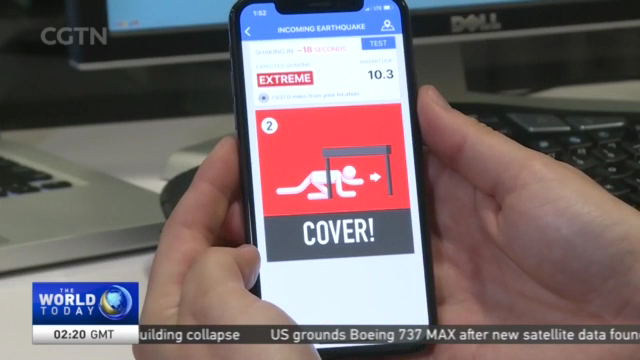
10:59, 14-Mar-2019
Earthquake Alerts: App warns LA residents of imminent earthquakes
Updated
10:50, 17-Mar-2019
02:55

More than ten-thousand earthquakes strike the state of California each year. Most, of course, aren't felt. But seismologists warn something major could hit at any time. And a new app, launched by the city of Los Angeles, aims at giving residents some warning. From Los Angeles, CGTN's Phil Lavelle has our story.
Nobody saw it coming.
"It was 4:31 in the morning."
But what if they had? 57 people killed, thousands injured in 1994's Northridge quake, 6.7 in magnitude. Would a few seconds warning have made a difference?
"A scalpel could be lowered during surgery, a train could be stopped."
It could next time. LA's residents alerted of an incoming shake direct to their phones.
PHIL LAVELLE LOS ANGELES "This place is on a constant state of standby. Seismologists fully expect what's been nicknamed 'the big one' at any time. Way bigger than Northridge. It's long overdue and the easiest way to get our attention via the devices we spend most of our lives looking at."
The app, called Shake Alert LA, available on iPhone and Android.
"This is what we call the big one."
Developed by the City of LA, sending warnings by push notifications, the kind you get with emails or news alerts, and using open-source data given out by USGS.
ROBERT DEGROOT US GEOLOGICAL SURVEY EARTHQUAKE SCIENCE CENTER "Across the west coast, we're installing 1,675 seismic stations, the devices that pick up the data when the earthquake reaches the surface."
"Your sensors basically say 'there's shaking coming, here's the data, do with it what you will'."
That's right, we want people to do whatever they can with it.
Wendy Yost is a major earthquake survivor, twice over.
WENDY YOST EARTHQUAKE SURVIVOR "I've been through two. I like to say that I've had my lifetime fill."
San Francisco in 1989. Northridge, four years later.
"Put yourself in that situation now, you get 15 seconds warning, what would you do?"
WENDY YOST EARTHQUAKE SURVIVOR "If I had 15 seconds warning in either of the earthquakes I was a part of, I probably would have gotten to a public space faster."
Deep in the bowels of the University of California, Los Angeles, they run earthquake simulations. Here, testing how concrete walls would hold up. They're big fans of the early warning system but know it won't mean equal warning for all.
PROFESSOR JOHN STEWART EARTHQUAKE EXPERT, UCLA "Where earthquake early warning is most effective is when the source, where the fault is rupturing, is far away from the site that we're concerned about."
And so California waits for the big one. Hoping the devices that make life increasingly convenient, one day help save lives from another one of these. Phil Lavelle, CGTN, Los Angeles.

SITEMAP
Copyright © 2018 CGTN. Beijing ICP prepared NO.16065310-3
Copyright © 2018 CGTN. Beijing ICP prepared NO.16065310-3